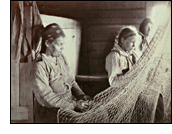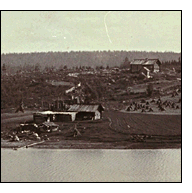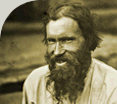 Although
the poems making up the Kalevala have been recorded from
the mouth of the people, the epic is not a mere collection of old
Karelian and Finnish folk poetry. Lönnrot took the material
at his disposal and created an imaginary, mythical poetic world,
fashioning the poems into a narrative to which he added lyric poems
and incantations. Yet Lönnrot himself, especially in preparing
the first edition of the Kalevala, thought that he was searching
for the original incarnation of a single epic which had become fragmented
over the course of time. In Lönnrot's day, and, indeed, for
decades thereafter, it was thought that Karelian and Finnish folk
poetry were based on historical events and told of actual figures
who had lived in ancient times and their gods. Although
the poems making up the Kalevala have been recorded from
the mouth of the people, the epic is not a mere collection of old
Karelian and Finnish folk poetry. Lönnrot took the material
at his disposal and created an imaginary, mythical poetic world,
fashioning the poems into a narrative to which he added lyric poems
and incantations. Yet Lönnrot himself, especially in preparing
the first edition of the Kalevala, thought that he was searching
for the original incarnation of a single epic which had become fragmented
over the course of time. In Lönnrot's day, and, indeed, for
decades thereafter, it was thought that Karelian and Finnish folk
poetry were based on historical events and told of actual figures
who had lived in ancient times and their gods.
When Lönnrot finished the manuscript of the first edition
of the Kalevala in 1835, he had some 40,000 lines of poetry
to work with. Over half of these he had collected in Viena.
 In
augmenting the epic to create the second edition, which appeared
in 1849, Lönnrot had some 170,000 lines of poetry at his disposal,
most of this material, of course, comprising variants of the same
poems. Of this extraordinary collection, some 1,200 poems - 43,000
lines - were from Viena; 1,150 poems - 22,000 lines from Ingria;
and a mere 140 poems - 5,000 lines - from Aunus. The remainder of
the material had been collected in different parts of Finland. But
when one recalls that most of the poetry collected from Viena was
narrative and most of that from Ingria lyric, Viena stands out as
the true "song-land of the Kalevala." Lönnrot himself
stated on many occasions that the village of Vuokkiniemi was "the
best and richest home of poems". Many later poetry collectors
have affirmed this view in the course of exploring the sites where
epic poetry was sung. In
augmenting the epic to create the second edition, which appeared
in 1849, Lönnrot had some 170,000 lines of poetry at his disposal,
most of this material, of course, comprising variants of the same
poems. Of this extraordinary collection, some 1,200 poems - 43,000
lines - were from Viena; 1,150 poems - 22,000 lines from Ingria;
and a mere 140 poems - 5,000 lines - from Aunus. The remainder of
the material had been collected in different parts of Finland. But
when one recalls that most of the poetry collected from Viena was
narrative and most of that from Ingria lyric, Viena stands out as
the true "song-land of the Kalevala." Lönnrot himself
stated on many occasions that the village of Vuokkiniemi was "the
best and richest home of poems". Many later poetry collectors
have affirmed this view in the course of exploring the sites where
epic poetry was sung.
|

 Although
the poems making up the Kalevala have been recorded from
the mouth of the people, the epic is not a mere collection of old
Karelian and Finnish folk poetry. Lönnrot took the material
at his disposal and created an imaginary, mythical poetic world,
fashioning the poems into a narrative to which he added lyric poems
and incantations. Yet Lönnrot himself, especially in preparing
the first edition of the Kalevala, thought that he was searching
for the original incarnation of a single epic which had become fragmented
over the course of time. In Lönnrot's day, and, indeed, for
decades thereafter, it was thought that Karelian and Finnish folk
poetry were based on historical events and told of actual figures
who had lived in ancient times and their gods.
Although
the poems making up the Kalevala have been recorded from
the mouth of the people, the epic is not a mere collection of old
Karelian and Finnish folk poetry. Lönnrot took the material
at his disposal and created an imaginary, mythical poetic world,
fashioning the poems into a narrative to which he added lyric poems
and incantations. Yet Lönnrot himself, especially in preparing
the first edition of the Kalevala, thought that he was searching
for the original incarnation of a single epic which had become fragmented
over the course of time. In Lönnrot's day, and, indeed, for
decades thereafter, it was thought that Karelian and Finnish folk
poetry were based on historical events and told of actual figures
who had lived in ancient times and their gods. In
augmenting the epic to create the second edition, which appeared
in 1849, Lönnrot had some 170,000 lines of poetry at his disposal,
most of this material, of course, comprising variants of the same
poems. Of this extraordinary collection, some 1,200 poems - 43,000
lines - were from Viena; 1,150 poems - 22,000 lines from Ingria;
and a mere 140 poems - 5,000 lines - from Aunus. The remainder of
the material had been collected in different parts of Finland. But
when one recalls that most of the poetry collected from Viena was
narrative and most of that from Ingria lyric, Viena stands out as
the true "song-land of the Kalevala." Lönnrot himself
stated on many occasions that the village of Vuokkiniemi was "the
best and richest home of poems". Many later poetry collectors
have affirmed this view in the course of exploring the sites where
epic poetry was sung.
In
augmenting the epic to create the second edition, which appeared
in 1849, Lönnrot had some 170,000 lines of poetry at his disposal,
most of this material, of course, comprising variants of the same
poems. Of this extraordinary collection, some 1,200 poems - 43,000
lines - were from Viena; 1,150 poems - 22,000 lines from Ingria;
and a mere 140 poems - 5,000 lines - from Aunus. The remainder of
the material had been collected in different parts of Finland. But
when one recalls that most of the poetry collected from Viena was
narrative and most of that from Ingria lyric, Viena stands out as
the true "song-land of the Kalevala." Lönnrot himself
stated on many occasions that the village of Vuokkiniemi was "the
best and richest home of poems". Many later poetry collectors
have affirmed this view in the course of exploring the sites where
epic poetry was sung.